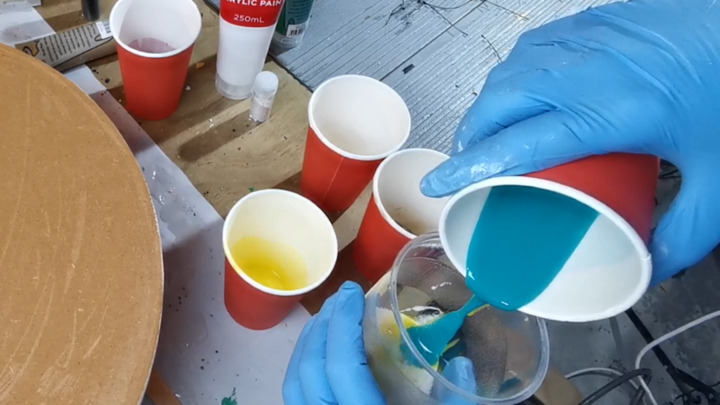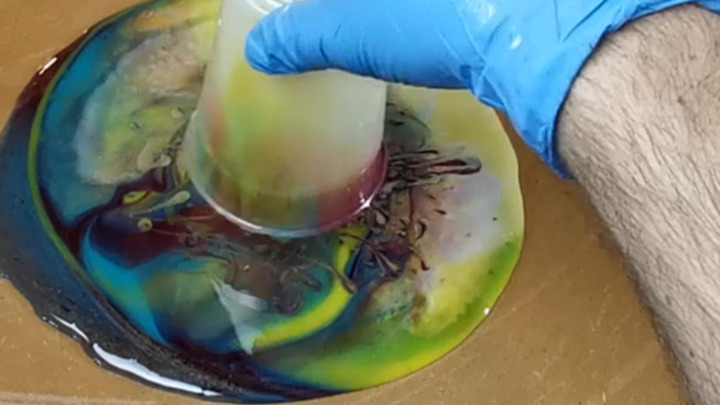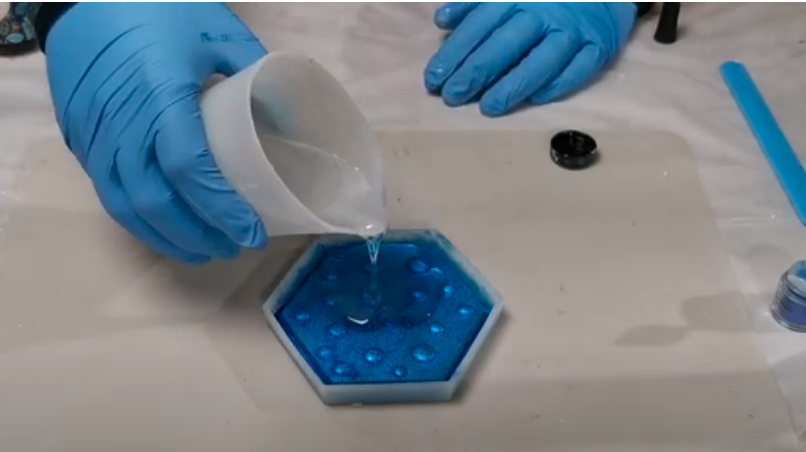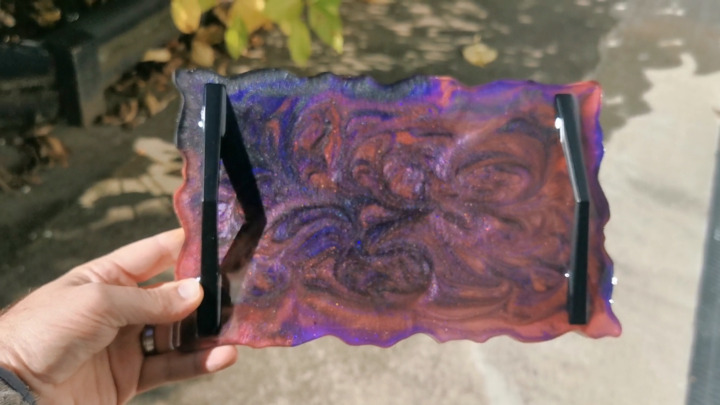Art has long been celebrated not only for its aesthetic value but also for its profound therapeutic effects. In recent years, resin art has emerged as a unique medium within the broader spectrum of art therapy, offering an innovative and engaging way to promote mental health and emotional well-being. This article looks at the concept of art as therapy dives into the benefits of resin art, and provides practical insights for incorporating resin art into therapeutic practices.

Table of Contents
Understanding Art Therapy
The Fundamentals of Art Therapy
Art therapy is a form of expressive therapy that uses the creative process of making art to improve a person’s physical, mental, and emotional well-being. Combining psychological theories with the creative process, art therapy helps people explore their emotions, develop self-awareness, manage stress, and enhance cognitive abilities. Creating something you made with your own hands can have the added benefits of providing a sense of accomplishment and a way to show the world your creativity.
Historical Context and Evolution
Art therapy has roots dating back to the mid-20th century, when pioneers like Margaret Naumburg and Edith Kramer began integrating art into psychotherapy practices. Over the decades, art therapy has evolved to encompass various techniques and mediums, reflecting the many ways in which art can facilitate mental healing and improve wellbeing.
Edith Kramer supported that there is a connection between making art and the Freudian concept of sublimation, which could be defined as a process in which destructive or self-destructive feelings or urges are transformed through art or work into socially productive and acceptable outcomes
The Therapeutic Benefits of Art
Psychological and Emotional Benefits
Engaging in art therapy can lead to significant psychological and emotional improvements. Creating art allows individuals to express thoughts and feelings that might be difficult to do so verbally or in a written medium. This process can help reduce symptoms of anxiety, depression, and trauma, fostering a sense of relief and accomplishment.
Physical and Cognitive Advantages
Beyond emotional well-being, art therapy offers physical and cognitive benefits. The act of creating art can improve fine motor skills, enhance hand-eye coordination, and stimulate brain function. It also encourages problem-solving and critical thinking, contributing to overall brain health.
“I could say things with color and shape that I couldn’t’ say any other way – things I had no words for” – Margaret Naumburg
Introduction to Resin Art
What is Resin Art?
Resin art involves using a two-part epoxy resin and hardener mix that makes a clear substance that hardens into a durable, glossy finish, to create stunning artworks. Resin can be poured, layered, and combined with various materials like pigments, inks, and objects to produce mesmerizing effects. The medium’s versatility makes it suitable for creating a wide range of art pieces, from resin abstract paintings to intricate jewelry. The variety of resin and the projects you can make is why I love it as an art medium.
Materials and Techniques
Creating resin art requires a few essential materials: epoxy resin, hardener, mixing tools, pigments or dyes, and safety equipment. Techniques can vary widely, from simple pouring and layering to more complex methods like embedding objects or creating geode-inspired pieces. The process is often experimental, encouraging artists to explore and innovate. The experimentation that you do with Resin is why I have called my YouTube channel and social media channels Andy’s Art Lab. I love experimenting with resin artwork hence the Art Lab reference.

Resin Art as a Therapeutic Tool
Emotional Expression and Release
Resin art offers a unique way to express and release emotions. The fluidity and unpredictability of resin allow for spontaneous and intuitive creation, making it easier for individuals to let go of control and embrace the creative process. This can lead to profound emotional release and insight. I always say with resin the image you have in your mind on what you create quite often does not match how it turns out and that can be in a good way.
Stress Reduction and Mindfulness
The process of creating resin art is inherently meditative. Mixing resin, choosing colors, and pouring layers require focus and patience, helping individuals enter a state of mindfulness. This can significantly reduce stress levels and promote a sense of calm and relaxation.
“Art washes away from the soul the dust of everyday life.” – Pablo Picasso
Practical Guide to Resin Art Therapy
Getting Started with Resin Art
To begin your journey with resin art, start with simple projects. Gather the necessary materials and ensure you have a well-ventilated workspace. Follow safety guidelines, such as wearing gloves and a mask, to protect yourself from fumes and skin contact. Experiment with basic techniques before moving on to more complex creations. I would recommend starting with creating resin in silicone molds. I find that creating resin coasters from a silicone mold is an easy first project that gives you plenty of scope to be creative.

Creating a Safe and Therapeutic Space
Creating a safe and therapeutic space is crucial for effective art therapy. Ensure your workspace is comfortable, organized, and free from distractions. Incorporate calming elements, such as soft lighting and soothing music, to enhance the therapeutic atmosphere. Encourage a non-judgmental environment where individuals feel free to express themselves without fear of criticism.
FAQs
What are the main benefits of art therapy?
Art therapy provides a number of benefits, including emotional expression, stress reduction, improved self-esteem, and enhanced cognitive function. It offers a creative outlet for people to explore and process their emotions in a safe and supportive environment.
How does resin art differ from other forms of art therapy?
Resin art is different as epoxy resin allows for unique techniques and effects not possible with other mediums. The fluid nature of resin encourages spontaneity and experimentation, making it a dynamic and engaging form of art therapy. Its also very versatile from creating wall art to art decor. You can let your imagination run wild with what you want to create with it.
Can anyone practice resin art therapy?
Yes, resin art therapy can be practiced by anyone, regardless of artistic skill level. The process of using resin as an art medium is highly intuitive and forgiving, making it accessible to beginners and experienced artists alike. It’s important to follow safety guidelines and start with simple projects to build confidence.
What safety precautions should be taken when working with resin?
When working with resin, always wear protective gear, including gloves and a mask, to avoid skin contact and inhalation of fumes. Work in a well-ventilated area and follow the manufacturer’s instructions for mixing and handling resin.
How can resin art help with stress management?
Resin art helps with stress management by promoting mindfulness and relaxation. The focused and repetitive actions involved in creating resin art can induce a meditative state, reducing stress and fostering a sense of calm.
What materials are needed to start resin art?
To start resin art, you will need epoxy resin, hardener, mixing tools, pigments or dyes, and safety equipment such as gloves and a mask. Additional materials like silicone molds, heat guns, and embedding objects can enhance your creative possibilities.
Conclusion
Resin art, as a therapeutic practice, offers a powerful way to harness the healing potential of art. By engaging in resin art, individuals can experience emotional release, stress reduction, and cognitive stimulation. Whether you are new to art therapy or an experienced practitioner, incorporating resin art into your therapeutic routine can unlock new dimensions of creativity and well-being. Embrace the journey of self-discovery and healing through the vibrant and versatile world of resin art.




